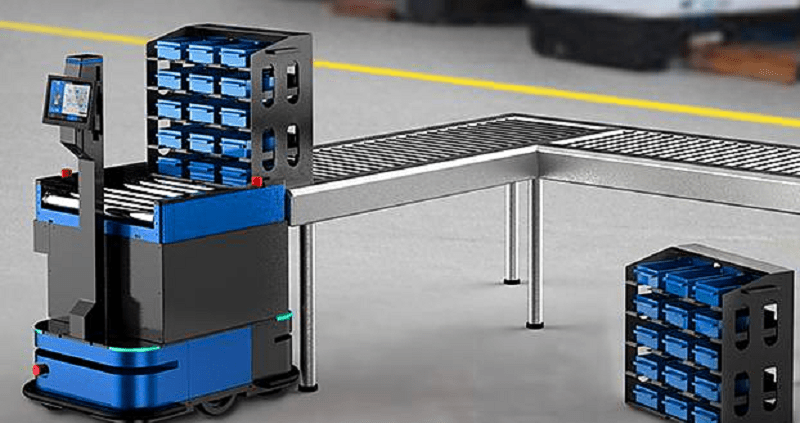What are the advantages of AGV
Advantages of AGV:
(1) High degree of automation;
It is controlled by computer, electronic control equipment, laser reflector, etc.
When auxiliary materials are needed in a certain part of the workshop, the staff enters relevant information into the computer terminal, and the computer terminal sends the information to the central control room. Professional technicians issue instructions to the computer. With the cooperation of electronic control equipment, this The instruction is finally accepted and executed by the AGV-send the auxiliary materials to the corresponding place.
(2) Charging automation;
When the power of the AGV car is about to run out, it will send a request instruction to the system to request charging (general technicians will set a value in advance), and automatically go to the charging place after the system allows it to “queue” for charging.
In addition, the battery life of the AGV trolley is very long (more than 10 years), and it can work for about 4 hours per 15 minutes of charging.
(3) Beautiful, improve the viewing degree, thereby enhancing the image of the enterprise.
(4) Convenience and reduced floor space; the AGV trolley in the production workshop can shuttle back and forth in each workshop.
In the early days, AGV trolleys could only travel in one direction during automatic operation, so the applicable environment was limited. In order to meet the requirements of industrial production, in recent years, there have been AGV products in foreign countries that can move forward and backward or even travel, forward, reverse, sideways and rotate in all directions during automatic operation. These achievements are attributed to the progress of the walking mechanism.
1. Two-wheel differential traveling mechanism This traveling mechanism has two traveling driving wheels symmetrically arranged on the front and rear centerline, and two supporting wheels are arranged at the vertices of an isosceles triangle with the fulcrum of the two traveling wheels as the base. The trolley relies on both sides of the driving wheel to steer differentially, so there is no need to set a steering wheel. The trolley has simple structure, reliable work and low cost. In the automatic running state, the trolley can move forward and backward, and can make vertical turns with good maneuverability. Compared with the four-wheel walking mechanism trolley with steering wheels, the trolley can be made smaller due to the omission of the steering wheel, which not only saves two driving motors but also saves space. In recent years, the trolley of this kind of organization has been widely used. In order to improve the lateral stability of the car body when driving, the two-wheel differential four-wheel walking mechanism can be improved as follows. The supporting wheels are increased from the original two to four and arranged at the four corners of the chassis of the trolley.
2. Three-wheel walking mechanism The three wheels of the AGV trolley of the three-wheel walking mechanism are respectively arranged on the three vertices of an isosceles triangle. The front wheel is both a steering wheel and a walking driving wheel. The two wheels behind are unpowered supporting wheels. The AGV trolley of the three-wheel traveling mechanism is simple in structure, easy to control, reliable in work, and low in cost. When the car is manual, it can forward, reverse and turn automatically. It can only drive in one direction. When turning, the trajectory of the rear wheel’s midpoint deviates from the track of the guide wire and presents a trailing line.
3. Four-wheel walking mechanism with steering wheel The four-wheel walking mechanism with steering wheel is evolved on the basis of three-wheel walking mechanism, which is equivalent to combining two tricycles together. The two supporting wheels are symmetrically arranged on the center line of the front and rear of the trolley. The front and rear wheels are respectively arranged symmetrically at the vertices of an isosceles triangle with the fulcrums of the two supporting wheels as the base. The front and rear wheels are both steering wheels and walking driving wheels. This kind of AGV trolley can travel in all directions under automatic operation. When turning, the front and rear wheels can track the trajectory of the guide wire. The maneuverability is better than that of the tricycle. It is suitable for narrow aisle work environment.
4. Other forms of walking mechanism In recent years, foreign companies have continuously researched new walking mechanisms. Among them, the symbolic one belongs to the walking organization of Sweden’s Mackanham Company. The running mechanism is novel in design and compact in mechanism. Four driving wheels are arranged on the four corners of the chassis in an articulated form. When running, the steering and speed of the four wheels are controlled separately, and the speed vector synthesis principle is used to realize driving. Later, Japan’s Mitsui Co., Ltd. cooperated with McCannham Company to make improvements on the original basis and launched the Mitsui Mackanham Wheel System, which has improved its performance. This AGV trolley can realize all-round driving.
With the rapid development of logistics systems, the scope of application of AGV is also expanding. AGV systems are researching and designing an unmanned car system solution based on electromagnetic navigation. Through actual hardware experiments, the system can meet the expected design requirements and can be widely used In the fields of industry, military, transportation, electronics, etc., it has good environmental adaptability, strong anti-jamming ability and target recognition ability.



